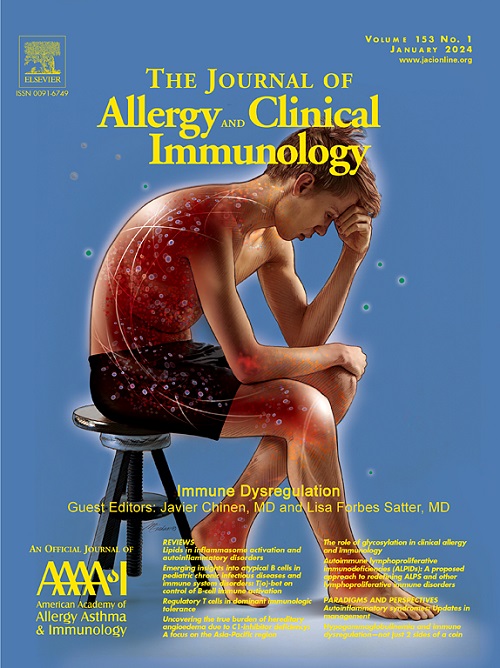Type 2 cytokines pleiotropically modulate sensory nerve architecture and neuroimmune interactions to mediate itch
IF 11.2
1区 医学
Q1 ALLERGY
引用次数: 0
Abstract
Background
Anti–type 2 cytokine therapies represent promising interventions for chronic itch; however, their precise mechanisms in restoring nerve architecture and mitigating inflammation and pruritus remain incompletely understood.
Objectives
This study aimed to elucidate the mechanistic roles of IL-4, IL-13, and IL-31 in the pathophysiology of itch associated with type 2 inflammatory skin diseases.
Methods
The effect of IL-4, IL-13, and/or IL-31 on neurite outgrowth and/or transcriptomic changes was analyzed in human and mouse dorsal root ganglion (DRG) neuronal cultures. Mouse ear pinnae were processed for histologic, transcriptomic, and proteomic analyses 4 days after intradermal injection of IL-4, IL-13, and/or IL-31. To evaluate functional correlations with neuronal responses, mice were subcutaneously challenged with IL-4, IL-13, and/or IL-31, and scratching behavior was monitored. Association between IL-4/IL-13–IL-4Rα axis and severity of atopic dermatitis was evaluated through correlative analyses of human DRG transcriptomic changes and atopic dermatitis transcriptomic datasets (GSE130588 and BioMaP-Consortium).
Results
IL-4 and IL-13 promote mouse and human DRG sensory neuron growth, with effects similar to or greater than IL-31. In mice, intradermal IL-4, IL-13, and IL-31 increased epidermal nerve growth; however, only IL-4 and IL-13 induced hyperplasia and immune cell recruitment. Multiomic analyses revealed that IL-4 and IL-13 have a broader impact on neuroimmune interactions than IL-31. In a murine DRG neuron–eosinophil coculture, IL-4Rα blockade reduced neurite growth. IL-13 and IL-31 elicited acute scratching, demonstrating their roles as direct pruritogens; IL-4 synergistically enhanced IL-13–induced itch, resulting in greater pruritic responses than IL-31. Additionally, a set of itch-associated genes upregulated by IL-4 and IL-13 and downregulated by dupilumab-mediated IL-4Rα blockade in human DRG neuronal cultures showed positive correlation with atopic dermatitis severity.
Conclusions
These findings establish the IL-4/IL-13–IL-4Rα axis as a key regulator of inflammatory skin nerve innervation, neuroimmune interactions, barrier integrity, and itch response, highlighting its mechanistic role in modulating sensory neuronal function and shaping the inflammatory microenvironment that drives itch pathophysiology.
2型细胞因子多向调节感觉神经结构和神经免疫相互作用介导瘙痒。
背景:抗2型细胞因子治疗是治疗慢性瘙痒的有希望的干预措施;然而,它们在恢复神经结构和减轻炎症和瘙痒方面的确切机制仍不完全清楚。目的:本研究旨在阐明IL-4、IL-13和IL-31在2型炎症性皮肤病瘙痒病理生理中的机制作用。方法:分析IL-4、IL-13和/或IL-31对人和小鼠背根神经节(DRG)神经元生长和/或转录组变化的影响。在皮内注射IL-4、IL-13和/或IL-31 4天后,对小鼠耳廓进行组织学、转录组学和蛋白质组学分析。为了评估与神经元反应的功能相关性,小鼠皮下注射IL-4、IL-13和/或IL-31,并监测抓挠行为。通过对人DRG转录组变化和AD转录组数据集(GSE130588和BioMap consortium)的相关性分析,评估IL-4/IL-13-IL-4Rα轴与AD严重程度的相关性。结果:IL-4和IL-13促进小鼠和人DRG感觉神经元生长,其作用类似或大于IL-31。在小鼠中,皮内IL-4、IL-13和IL-31促进表皮神经生长;然而,只有IL-4和IL-13诱导增生和免疫细胞募集。多组学分析显示,IL-4和IL-13对神经免疫相互作用的影响比IL-31更广泛。在小鼠DRG神经元-嗜酸性粒细胞共培养中,IL-4Rα阻断可减少神经突生长。IL-13和IL-31可引起急性抓伤,显示其作为直接致痒剂的作用;IL-4协同增强il -13诱导的瘙痒,导致比IL-31更大的瘙痒反应。此外,在人DRG神经元培养物中,一组瘙痒相关基因被IL-4和IL-13上调,被dupilumab介导的IL-4Rα阻断下调,与AD严重程度呈正相关。结论:这些发现证实了IL-4/IL-13-IL-4Rα轴是炎症性皮肤神经支配、神经免疫相互作用、屏障完整性和瘙痒反应的关键调节因子,强调了其在调节感觉神经元功能和塑造炎症微环境中驱动瘙痒病理生理的机制作用。
本文章由计算机程序翻译,如有差异,请以英文原文为准。
求助全文
约1分钟内获得全文
求助全文
来源期刊
CiteScore
25.90
自引率
7.70%
发文量
1302
审稿时长
38 days
期刊介绍:
The Journal of Allergy and Clinical Immunology is a prestigious publication that features groundbreaking research in the fields of Allergy, Asthma, and Immunology. This influential journal publishes high-impact research papers that explore various topics, including asthma, food allergy, allergic rhinitis, atopic dermatitis, primary immune deficiencies, occupational and environmental allergy, and other allergic and immunologic diseases. The articles not only report on clinical trials and mechanistic studies but also provide insights into novel therapies, underlying mechanisms, and important discoveries that contribute to our understanding of these diseases. By sharing this valuable information, the journal aims to enhance the diagnosis and management of patients in the future.

 求助内容:
求助内容: 应助结果提醒方式:
应助结果提醒方式:


